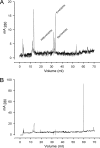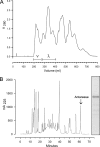Vesicle-associated membrane protein (VAMP) cleavage by a new metalloprotease from the Brazilian scorpion Tityus serrulatus
- PMID: 20026600
- PMCID: PMC2844189
- DOI: 10.1074/jbc.M109.028365
Vesicle-associated membrane protein (VAMP) cleavage by a new metalloprotease from the Brazilian scorpion Tityus serrulatus
Abstract
We present evidence that venom from the Brazilian scorpion Tityus serrulatus and a purified fraction selectively cleave essential SNARE proteins within exocrine pancreatic tissue. Western blotting for vesicle-associated membrane protein type v-SNARE proteins (or synaptobrevins) reveals characteristic alterations to venom-treated excised pancreatic lobules in vitro. Immunocytochemistry by electron microscopy confirms both the SNARE identity as VAMP2 and the proteolysis of VAMP2 as a marked decrease in secondary antibody-conjugated colloidal gold particles that are predominantly associated with mature zymogen granules. Studies with recombinant SNARE proteins were used to determine the specific cleavage site in VAMP2 and the susceptibility of VAMP8 (endobrevin). The VAMP2 cleavage site is between the transmembrane anchor and the SNARE motif that assembles into the ternary SNARE complex. Inclusion of divalent chelating agents (EDTA) with fraction nu, an otherwise active purified component from venom, eliminates SNARE proteolysis, suggesting the active protein is a metalloprotease. The unique cleavages of VAMP2 and VAMP8 may be linked to pancreatitis that develops following scorpion envenomation as both of these v-SNARE proteins are associated with zymogen granule membranes in pancreatic acinar cells. We have isolated antarease, a metalloprotease from fraction nu that cleaves VAMP2, and report its amino acid sequence.
Figures











References
Publication types
MeSH terms
Substances
Associated data
- Actions
Grants and funding
LinkOut - more resources
Full Text Sources
Other Literature Sources
Research Materials

